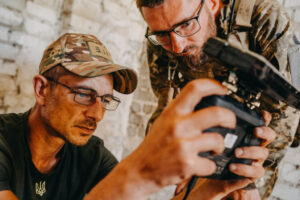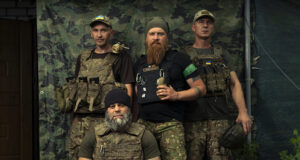“We saw four of these fucks going into a house, so we decided to strike it with our artillery. To our surprise there was a huge explosion. Clearly, they were using the place to store ammo. Then soldiers started pouring out of the basement. So we just started shooting them.” Vlad pulls up a video on his phone. I see a smouldering building and fleeing Russians. He swipes right and zooms in on a photo. “See: dead Russians.”
The Ukrainian 3rd Tank Brigade has been fighting in Kharkiv Oblast since last year. If things were bad in the beginning, they are even worse now. A few days ago, Ukrainian sources reported that the Russians have concentrated more than 100,000 soldiers, 900 tanks and 370 multiple rocket launch systems. According to Serhii Cherevatyi, Ukrainian Deputy Commander for Strategic Communications of the Eastern Military Grouping, Russia has also deployed airborne units and the best motorised infantry units there.
Kupyansk has always been of huge strategic importance for both Ukraine and Russia. Located 120km from Kharkiv, Ukraine’s second city, it has been, since the late 19th century, a vital railway junction: five lines intersect there and at the adjacent town of Kupyansk Vuzlovyi. One of these lines leads into Russia, making the city a vital logistics hub for the invading forces. This is largely why the Russians went for Kupyansk immediately after last year’s full-scale invasion, viewing it as a potential regional headquarters. They were welcomed into Kupyansk with no military or political resistance: the city’s mayor reportedly spoke to a Russian commander over the phone, and then simply surrendered. When Ukrainian forces destroyed a bridge into the town to try to slow the Russian advance, the mayor helped the invading troops find an alternative route.
The Russians treated the population with typical brutality — torturing them and forcing them sign documents pledging loyalty to Russia — until Ukrainian forces liberated them on 9 September 2022. As the Russians retreated across the Oskil river they turned their artillery on Kupyansk, destroying civilian infrastructure and demolishing a hospital, as well as a care home for the elderly and mentally ill.
Cut off from supplies along the northeastern front, the Russians have been pounding Kupyansk ever since. As of March 2023, only around 20% of the city’s pre-war population remained. But, in this instance, turning the city’s population into Russians is of less importance to Moscow than seizing its infrastructure. Not only does it house valuable rail connections to towns in northern Ukraine and Russia, but also to the Donbas. This means that control over the town is key in Ukraine’s efforts to continue fuelling their advances in the south.
I arrive at a small base tucked away behind a rusted iron gate that opens into a courtyard strewn with gym equipment. Free weights, a barbell and a pull-up bar bolted to the wall set the scene. A punch bag hangs on a chain dangling from the ceiling. Testosterone is heavy in the air.
The soldiers sleep inside a squat brick building. Pinned to the wall in one of the rooms are nine football scarves — the men are from a battalion formed from football ultras in eastern Ukraine. “We have been fighting in the Kharkiv area the whole time and across the area — in Izyum and Balalka,” explains Maks, a thin man with a scraggly dark stubble. The battalion is officially intelligence, but the man here often fight hand to hand, and Maks shows me a Wagner patch he has. “I found it in the field,’ he tells me with a grin. The battalion was the first to defend the area and then to go on the offensive. We were in the first line during the liberation at the end of last year.
Now the fighting is heavier than ever. Russian attacks have ramped up around Kupyansk, and it is a sign of things to come: a Russian drive to retake the town to seize its supply lines for its defence in the Donbas. As Ukraine makes gains in the south, Russian forces may try once again to refocus efforts to gain control over vital infrastructure in the north. The Commander of the Ground Forces of the Ukrainian Armed Forces, Colonel-General Oleksandr Syrski was clear about this earlier in the week: “In order to stop the offensive actions of our troops in the area of Bakhmut, the enemy is actively transferring additional forces and means to this direction, the basis of which are parts of the airborne troops.”
It was in Bakhmut that Syrsky pioneered the strategy of “active defence” — using defence to whittle down enemy troops. He decided Ukrainian forces would stay in Bakhmut to grind down Russians troops, believing that, at close quarters, his men are better fighters. This has been controversial, a source told me, because the Ukrainians have lost many mid-level commanders in the fight for the city. Seen from a broader strategic view, however, the benefits are clear.
According to Adam Ure, former head of the Foreign Office’s open-source capability, “Syrsky in many ways embodies the Ukrainian approach to the war, and why Kyiv has been so successful in resisting the Russian invasion.” He is a compulsive reader, receptive to European and American military strategy and tactics, which he has implemented into his creative and innovative responses. “Perhaps most crucially”, Ure continues, “he has displayed much of Ukraine’s ‘beehive’ approach to its defence, delegating astutely and enabling subordinates to take the initiative on a local level. This is a marked contrast from the Russian army, which is still mired in outdated Soviet tactics and does not give room for individual activity.”
Kupyansk, as a result, has now become vital to the dance that is the Ukrainian counteroffensive. According to one military source, while it is likely that the Ukrainians have probably exaggerated the figure of 100,000 Russian troops, what is clear is that they are now trying to push through in Kupyansk as, thanks to Sirsky’s tactics, the Ukrainians are on the verge of encircling Bakhmut. What is also clear, I was told, is that the Russian have assembled a bigger strike force than expected. This means that sides are now engaged in a simple game: sending their reserves to the front to whittle the enemy down. There is a chance the Russians will get through, but it will come down to who has the most reserves — and here the Ukrainians have the advantage by some distance. So far, they have committed less than half of their fighting reserves to the counteroffensive (they have 25-30 Brigades of 3,500-4,000 men, and have used about eight of them so far).
Still, it is a far from ideal situation for Ukraine: the high command was not expecting such a large-scale Russian fightback, but this has come because they have made headway elsewhere. Ever since Syrsky organised and led the defence of Kyiv early last year, Ukrainian tactics have developed an unprecedented creativity. Even before the Kharkiv counteroffensive, he had succeeded in pushing back Russian forces — reducing their artillery threat to the city. This was vital. Then, a few months later, one again he did the unthinkable: he sent the Russians scuttling back across the border.
A source exclusively revealed to me just how he did it. “He pretended the troops he’d amassed there weren’t even there.” First, he hid them in forests. And then he gave them fake battalion numbers, turning a critical mass of elite Ukrainian forces into a territorial defence unit (Ukraine’s equivalent of reservists). To the Russians intercepting radio communications it appeared that the soldiers around Kharkiv were not a serious threat. They were wrong — and in early September, Ukraine’s lightning counteroffensive pushed them out of the Kharkiv region. It was another stunning victory for Ukraine — and Syrsky.
“He makes organised plans,” explains Maks, “but in my opinion the most important thing is that we have no fear”. His friend Caravan, who is wearing a blue Dnipro football shirt and army trousers, chips in: “It’s not only Syrsky,” he adds. “The counteroffensive is the product of a lot of factors; it’s a team effort of all the generals who work well together.” This is partly because they don’t have a choice. Compared to Russia, Kyiv has significantly fewer generals, so they all must perform, while Russia can change its underperforming generals regularly.
But problems remain. Kupyansk shows that the Russian can amass a force very quickly in key positions. As Maks points out, Ukraine has problems, not least when it comes to manpower. Reservists are generally conscripts, not volunteers like his battalion, and they tend to be less motivated and less skilled. “By now many volunteers are dead, or they left the country, and that impacts on the situation on the front,” he says. “This is becoming a problem.”
But if this is a problem for the Ukrainians, it is even worse for the Russians, who are throwing their soldiers — often forced to the front with little training — in “meat waves” at the Ukrainian positions. Faced with these relentless attacks, each Ukrainian victory is not just military but political. Moscow must be made to understand that the cost of continuing the war is too great, and that it is time to consider other options. The degree to which Kyiv can make Putin understand this will come down to how it performs over the coming weeks — and for that Kupyansk is now vital.
Disclaimer
Some of the posts we share are controversial and we do not necessarily agree with them in the whole extend. Sometimes we agree with the content or part of it but we do not agree with the narration or language. Nevertheless we find them somehow interesting, valuable and/or informative or we share them, because we strongly believe in freedom of speech, free press and journalism. We strongly encourage you to have a critical approach to all the content, do your own research and analysis to build your own opinion.
We would be glad to have your feedback.
Source: UnHerd Read the original article here: https://unherd.com/



